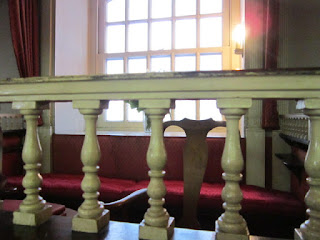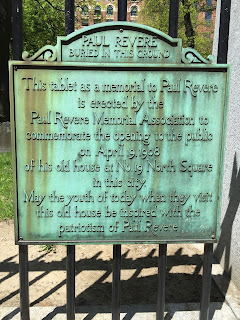Tremont Street's first place of interest was King's Chapel and King's Chapel Burying Grounds.
The Chapel is Unitarian in theology, Anglican [Episcopalian] in worship, and Congregational in governance. The granite building was built in 1754 and is often referred to as the "Stone Chapel". The congregation was founded in 1686 as the first Anglican Church in Colonial New England, and later in 1785 became the first Unitarian Church in America. I was intrigued that the church offers Evensong - something I only associated with churches in England. The interior was beautiful.
The chapel's unique seating is original "box pews" where families paid a yearly rental fee to decorate their box of pews to their own liking. No worries about someone taking their seat if they rented it and it belonged exclusively to them! ;-) Box pews were new to me. Have you heard of them?
Attendees of King's Chapel include George Washington, Paul Revere, Benjamin Franklin, John Hancock, Oliver Wendell Holmes and author, Louisa May Alcott. Below is a side box section underneath the upper balcony.
Attendees of King's Chapel include George Washington, Paul Revere, Benjamin Franklin, John Hancock, Oliver Wendell Holmes and author, Louisa May Alcott. Below is a side box section underneath the upper balcony.
Founded in 1630, the cemetery is the oldest cemetery in Boston, and is on the Freedom Trail route. It is situated next to King's Chapel. It was Boston's only burial site for 30 years. Among those buried there are John Winthrop [first governor of Massachusetts], and Mary Chilton, the first woman to step off the Mayflower.
Years of weathering has made some of the tombstones almost unreadable.
Down from King's Chapel and cemetery [on the opposite side of Tremont] is Granary Burial Ground [also part of Freedom Trail]. It was established in 1660, and is the city's third oldest cemetery. Three signers of the Declaration of Independence are buried there - John Hancock, Samuel Adams, and Robert Treat Paine, as well as eight governors, Paul Revere, five victims of the Boston Massacre, and several of Boston's Revolutionary War Patriots.
~ The arch is the gateway to the cemetery. ~
Somewhere between 5,000 - 8,000 people are estimated to be buried in the small cemetery under 2,345 grave markers [up to 20 bodies beneath each tombstone]. The granite obelisk in the center of the graveyard marks the graves of Benjamin Franklin's parents.
The cemetery was bustling with tourists and groups of school children.
Next to the cemetery is Park Street Congregational Church, founded in 1804 and built in 1809. The church's 217 foot steeple was once the first landmark travelers saw when approaching Boston, and is still a visible landmark from several Boston neighborhoods.
Directly across from the church on the corner of Park and Tremont streets begins the the Boston Common. [It is also the starting point of the Freedom Trail.] Downtown Boston's public central park dates back to 1634, and is the oldest city park in the United States. The park's current landscape configuration was downsized to 24 acres [from 50 acres] in 1860, and anchors the 'Emerald Necklace', a system of connected parks and parkways that winds through many Boston neighborhoods. It was a beautiful day, and Bostonians were enjoying the park. It reminded me of the parks in London, England.
Boston has a subway system [America's first], and its history and a diagram was posted in Boston Common.
Included in Boston Common is Lafayette Mall where a bronze plaque honors the Frenchman, Marquis de Lafayette, a Revolutionary War Patriot.
Jerry and I cut through Boston Common to Beacon Street, our lunch destination - tomorrow's post.
























This is such a fun trip! Thanks for sharing it with us!
ReplyDeleteBeautiful churches and park!
ReplyDelete